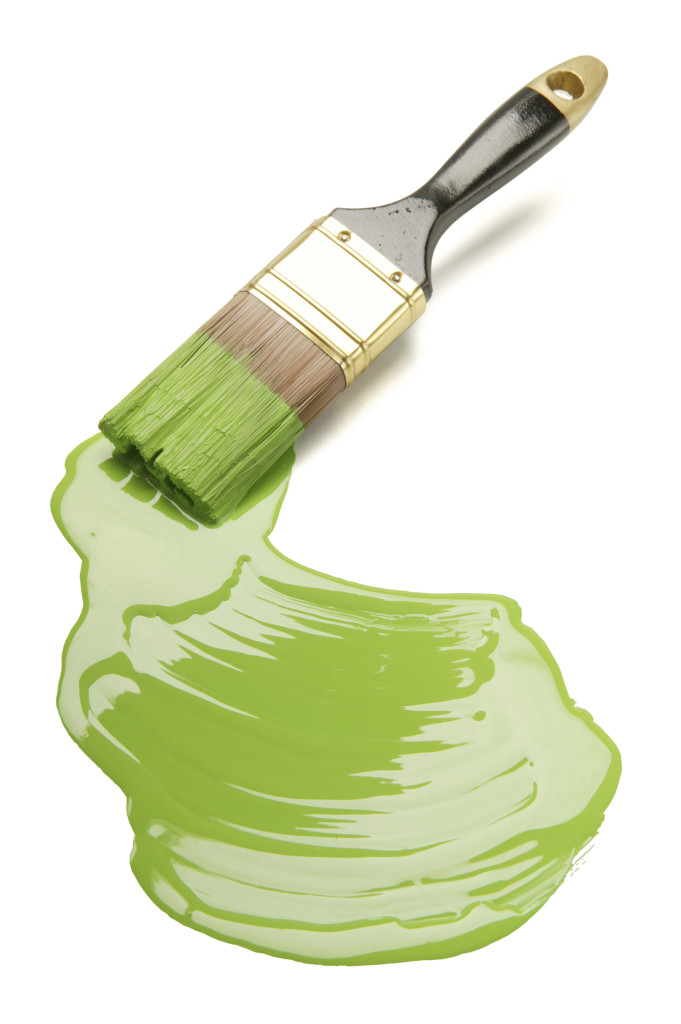It’s Good to Be Green
 Not since prehistoric painters adorned their cave walls with a mixture of mashed fern leaves and flower petals has paint been so environmentally friendly. But even those club-waving cavemen would feel pretty out of place in today’s billion-dollar coatings landscape.
Not since prehistoric painters adorned their cave walls with a mixture of mashed fern leaves and flower petals has paint been so environmentally friendly. But even those club-waving cavemen would feel pretty out of place in today’s billion-dollar coatings landscape.
The U.S. paint and coating manufacturing industry includes about 950 companies with a combined annual revenue of about $27 billion; globally, revenue tops $130 billion, according to the World Paint & Coatings Industry Association.
That’s big business. But many of the major players in the industry are chasing a different kind of green these days, showing more concern for Mother Earth than padding the bottom line.
For Chris Connor, executive chairman and CEO at Sherwin-Williams, creating products that are good for the planet is vitally important. “Sherwin-Williams is committed to global leadership and excellence in environmental health and safety throughout our operations, businesses and products,” he said. “In order to fulfill this commitment we develop, implement and work to continually improve our global management systems, EHS standards and performance measures.”
Those words also echo loudly for Robert Wendoll, director of environmental affairs at Dunn-Edwards Paints, who says his company, “is firmly committed to the green principle of eco efficiency, which we define as the ability to satisfy human needs in ways that minimize adverse impacts on energy and material resources, environmental quality, and human health and safety … We believe this commitment is in the best interests of our workers, customers, and the public at large.”
GROWING GREEN
Paint has not always been warm and fuzzy with the environment. However, the movement by manufacturers to be more environmentally sensitive has been picking up steam in recent years.
The history of the green movement started way back in the early 1960s, says Davis Kyle, executive VP of the Master Painters Institute.
“There was a book that was titled the Silent Spring (author Rachel Carson, 1962), and it has been credited for launching most of the green-movement concerns of the environment,” Kyle says. “Even in the late ’60s, there was this move toward, ‘our world is a precious commodity and we have to look after it.’ We had things like the smog issues in LA that led to the whole concept of studying what VOCs (volatile organic compounds) were doing to the environment. With that came a real desire for the regulation, which covered those areas. And the rest of the world is starting to catch up.”
“Historically, the industry has made tremendous progress,” says Wendoll. “During the past 50 years, architectural coatings have gone from being 95% solvent-borne to 95% waterborne, and the VOC content of waterborne paints has been drastically reduced; white lead carbonate and other toxic pigments have been entirely replaced with safer alternatives; mercury biocides and many other potentially hazardous ingredients are gone. And yet, the performance of coatings is generally as high, or higher, than any time previously.”
Kyle feels performance is an important factor sometimes lost in the green discussion.
CERTIFIED GREEN
So, how green is green? Today, coatings manufacturers are clearly labeling their products for eco-friendliness— low or zero VOCs—with independent certification and LEED (see sidebar) compliance coming from organizations such as Green Seal, GREENGUARD, Scientific Certification Systems— and MPI, which sets the standard for the U.S. government’s paint program. MPI’s Extreme Green Standard is the most rigorous environmental standard in the world.
“At Sherwin-Williams, we have made some major strides in the reduction of VOCs in our architectural formulations with < 50 g/L VOC,” says Rick Watson, the company’s director of product information & technical services. “We manufacture our own colorants (ColorCast Ecotoner), meaning VOCs will not be added to any Sherwin-Williams product tinted with them, and the colorants are GREENGUARD Gold certified. We also take into consideration LEED, South Coast Air Quality Management District, California Air Resources Board, and all of the environmental regulations applicable to the marketplace.”
Many of Rust-Oleum’s Sierra brands are Green Seal certified to the GS-11 standard.
“A Green Seal certification means the product works well, reduces waste by using recovered material, and protects both the environment and human health,” says Nathan Ferraro, product manager at Rust-Oleum. “Our Sierra brand products also meet requirements for achieving credits under the LEED rating system, like indoor air quality—along with meeting USDA requirements for incidental food contact.”
PAY IT FORWARD
For Kyle, it comes back to performance.
“The industry believes that low VOC is the answer. Period,” he says. “You need to have a low-VOC product, undoubtedly. But it has to be a product that is going to actually work. It falls on us, the manufacturers, to educate end users on the fact that quality isn’t cheap.”
Wendoll agrees. “Paints and coatings are formulated for specific performance characteristics to meet the demands of different situations; different substrates, exposure conditions, functional requirements, economic needs, etc. In our view, products that are less durable do not qualify as green, no matter what they do or do not contain, because performance is the key characteristic of green paints. Coatings are not merely decorative, but are also protective of building substrates—and this provides enormous environmental benefits through conservation of energy and material resources.”
WHAT’S NEW
One new eco-star from Sherwin-Williams is Harmony Interior Acrylic Latex Paint.
“We’ve embraced technologies for eliminating odor and reducing formaldehyde,” Watson says. “Harmony paint’s odor-eliminating technology helps reduce common indoor odors, and its formaldehyde-reducing technology helps improve indoor air quality by reducing formaldehyde and aldehydes from possible sources like insulation and carpet, cabinets and fabrics. The length of time Harmony paint actively reduces odors and formaldehyde depends on the concentration, the frequency of exposure, and the amount of painted surface area.”
Watson says Harmony paint is also certified to GREENGUARD Gold standards for low chemical emissions into indoor air during product usage.
“We formulate our products based on what the customer is looking for, as well as specific projects or jobs,” Watson says. “We designed our Pro Industrial product series for higher performance characteristics. We have a high-performance epoxy specifically for areas that are wet and moist. We have acrylics—the Pro Industrial Acrylic Coating and DTM Acrylic Coating—that are GREENGUARD Gold certified. And our Pro Industrial Pre-Catalyzed Water-Based Epoxy is also GREENGUARD Gold certified and is chemical resistant and washable. Not only can it be used in hospitals, it can be specified in surgical suites.”
New from PPG are WONDER-PURE Zero-VOC Interior Latex Paint and WONDER-PURE Primer products, which offer durability, low odor, and good hide and coverage. This line is ideal for environments such as schools, hotels, hospitals and offices.
Another zero-VOC line from PPG is SPEEDHIDE Interior Acrylic Latex Paint, a low-odor paint perfect for painting occupied spaces, while its quick-dry formula allows for a fast recoat and a uniform, scrubbable finish. This product provides good hide, touch-up and application properties for interior walls, ceilings and trim.
Ferraro says Rust-Oleum has just released several new eco-friendly gloss sheens for its commercial/ industrial-grade products, which provide more aesthetic options for institutional applications.
“These products fall under the Sierra brand and are designed for schools, hospitals, etc., which are committed to sustainability,” Ferraro says. “Commercial/ industrial products are typically used with glossier sheens than residential. Industrial environments require a tougher resin to withstand higher traffic, chemical exposure, and wash-downs. We are seeing increased interest in using the more durable industrial-grade products in institutional settings for longer times between repainting.
Benjamin Moore’s Natura Waterborne Interior Paint continues that company’s commitment to providing the most environmentally friendly products available with zero VOCs and zero emissions. Natura was voted 2015’s Product of the Year by 40,000 consumers in a national representative survey conducted by consumer research partner TNS.
Wendoll says Dunn-Edwards has several exciting new products in the works. “We continue to work on the paint industry’s Holy Grail: nonhazardous waterborne paints that perform in all respects as well as, or better than, traditional solvent-borne alkyd paints.”
“The scope of green products is essentially a continuum,” Ferraro says. “The paint industry has made a lot of progress in the last 50 years, but much more will be done in the next 50 and beyond.”




